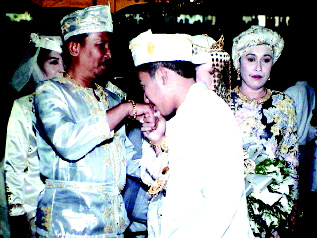 The blending of Islamic and pre-Islamic elements in the Filipino Muslim process of acculturation is a unique feature of ethnic cultures in the region. Courtship and marriage are reflections of this uniqueness.
The blending of Islamic and pre-Islamic elements in the Filipino Muslim process of acculturation is a unique feature of ethnic cultures in the region. Courtship and marriage are reflections of this uniqueness.
Family involvement in marriage is still a practice even among the Muslims of today, although in a lesser degree of rigidity as before. Even distant relatives of both sides are given the right to voice their opinion on any proposed union.
Notwithstanding the prohibition of Islamic law that women should not get married against their will, Muslim parents often prevail in a marital decision. Union is based on family status in the community. Though the Muslim male is allowed to marry a woman not belonging to his social level, the female is not allowed the same right.
Marriage outside religious lines was once taboo but is now tolerated, particularly among educated Filipino Muslims. Attitudes towards pre-marital sex amongst the Christian Filipinos have slowly been changed, but Muslims engaging in the same run the risk of disapproval of marriage plans or the imposition of customary penalties.
In the old days, marriage was arranged by parents without considering the true feelings of their children. Marriage based on true love or affection as very rare. Daughters were not consulted on marriage decisions. Her feelings towards the man were ignored and unimportant. The parents, after all, were regarded as the best person who could judge what was right or wrong for their children.
But the advent of modern living has started to lessen the rigidity of parental intervention. As a result, contemporary Muslim marriage is now determined and governed more by the decision of both the parties concerned in cooperation with the parents and their families.
As practiced, the selection of the bride is based on the status, wealth, prestige and power of the bride’s family. A bride’s personality including her capacity to fit into the role of a wife or mistress, as the case may be, is also looked into. Other considerations include education, training, and experience.
The bridegroom is chosen basically on the basis of his wealth, parent’s status, his reputation as a worker and ability to get along with his future in-laws and people. He is also judged by his potential as a protector of his extended kinsmen’s honour.
The traditional marriage among Filipino Muslims takes place at as young as an age as 17 for the groom and 15 for the bride. The Samals marry even younger. Today, the timing of marriage is affected by such considerations as the need for education and capacity of the bridegroom’s family to raise the bride gift, similar to the dowry requirements of other ethnic groups.
Parents make arrangement of the marriage of their children, the father’s consent being necessary for the marriage of a daughter. Couple who marry against this tradition are usually ostracised socially and, in worse cases, parents may even disown them. Restoration of recognition is only made when both parties accept the punishment which in the past was 50 lashes with a piece of rattan, or some other severe punishment prescribed by customary law.
Among the Tausugs, the marriage preparations start at least one day before the schedule date. During that day, a gift to the bride is delivered by the groom’s relatives. Failure or deviation from what was agreed would be sufficient reason to forgo the plan. Early the next morning, kinsmen, friends, and guests of the couple gather during the morning at the parties’ respective houses. A cow or water buffalo is slaughtered for the feasting while professional musicians provided gong music for the merry-making and socials. In the evening, the actual marriage ceremony is held and performed in Arabic. The newlywed couple begin married life in the girl’s household and later move to the groom’s parents’ home or build their own house.








Leave a Reply